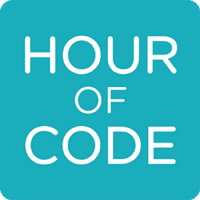If you decide to introduce your students to the site for the first time, have them choose to build with Blocks. The site provides all the directions and navigation from there on. Have fun learning!
Wednesday, December 16, 2015
Hour of Code Week is Over but Coding Never Ends
Thousands of Westerville City Schools students enjoyed exploring coding activities during Hour of Code Week. It was wonderful watching our students work through self-paced modules learning and discovering code or at least the building blocks of code. If you missed this opportunity, no worries, the modules are still on the Hour of Code web site. With Friday, December 18th being our last day before break and the opening day of the Star Wars movie, it might be a fun learning experience for your students to work through the Star Wars coding module. The modules are self-paced, easy to navigate and best of all you do not need to know code to enjoy working through the activities.
If you decide to introduce your students to the site for the first time, have them choose to build with Blocks. The site provides all the directions and navigation from there on. Have fun learning!
If you decide to introduce your students to the site for the first time, have them choose to build with Blocks. The site provides all the directions and navigation from there on. Have fun learning!
Monday, December 14, 2015
Revised Ohio Technology Learning Standards are open for public comment
The revised Ohio Technology Learning Standards are now open for public
comment. Please click here to
participate in the online review of the draft standards. Ohio educators from all content areas and the public
are invited to participate. The survey will remain open through December
31, 2015.
We appreciate your
feedback!
Monday, December 7, 2015
Connecting Outside the Classroom
How Tech Tools Help Us Learn Together Globally
A Walnut Springs student conducts an interview with a researcher at the Scott Polar Research Institute in Cambridge, UK. See below for the 7th grader's comments on the project and click the link to watch the interview.
#WestervilleWay
A Walnut Springs student conducts an interview with a researcher at the Scott Polar Research Institute in Cambridge, UK. See below for the 7th grader's comments on the project and click the link to watch the interview.
In looking for an interview for my National History Day
project, I contacted the Scott Polar Research Institute in Cambridge, UK. I spent 30 minutes in a Skype Interview. We used an iPad, a microphone, and a camera to record the session. Through this process I experienced a connection from halfway around the world and I met a professional in the field of my research. She shared interesting facts that I would not have found otherwise.
Brendan Smucker
7th Grade
Walnut Springs Middle School
Click here to view the interview:
 |
| Brendan Smucker conducts an interview with the Scott Polar Research Institute |
Labels:
#WestervilleWay,
camera,
distance learning,
edtech,
interview,
iPad,
microphone,
National History Day,
skype,
tech,
Walnut Springs
Hour of Code

For many people, computer programming, or "coding," is a topic that seems like a foreign language. In a lot of ways it is. There is an entire language that needs to be learned to be able to write a computer program that directs a computer, tablet or app what to do. However, its not as complicated as many make it out to be. In fact, HourOfCode.org has put coding in simple terms for everyone, starting at age 4, and also has "unplugged" tools to learn code if a computer is not available.
So what is the "Hour of Code?"
"Launched in 2013, Code.org® is a non-profit dedicated to expanding access to computer science, and increasing participation by women and underrepresented students of color. Our vision is that every student in every school should have the opportunity to learn computer science. We believe computer science should be part of core curriculum, alongside other courses such as biology, chemistry or algebra." - code.org/about
Hour of Code 2015
Essentially, the Hour of Code was created to break the misconceptions about coding, and get a new generation into creating online material. As our country moves away from the industrial age of manufacturing, and into the technological age of computers, understanding computers and how they work will be a highly marketable skill. The Hour of Code is a chance for people of all ages, races, genders, socioeconomic and computer skill levels to be introduced to one of the most needed areas of software development in a fun, differentiated learning environment.
Hour of Code Introduction
Hour of Code: Star Wars Introduction
Hour of Code: Minecraft Introduction
So if you haven't, check out Code.org, log in with your GAFE account (all teachers and students already have them) and start learning how to code. Its easy, its free, its educational, and most importantly, its enjoyable! The goal is for everyone to spend one hour playing with the games, but if its introduced to students, its almost guaranteed that they will continue to spend much more time on their own learning how to code. Give it a shot this week!

Thursday, December 3, 2015
If you are not using Google Maps to teach Geography, why not?
I found this short article, "Explore Machu Picchu in Google Maps and the Google Cultural Institute,"from Richard Byrne about Google Maps and more specifically Google Street View. If you go to Google Street View you will find 360 degree views of locations from around the World. If you have not looked at this, it will amaze you. There are image collections from over 65 countries including Loch Ness, Northern Lights in Finland, Taj Mahal and even under the oceans of the World. It is a phenomenal collection and paired with Google Maps a powerful resource to teach Geography.
Subscribe to:
Posts (Atom)



